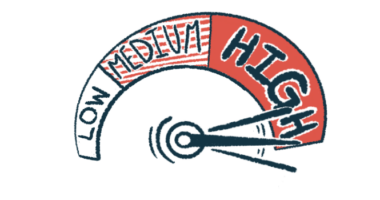Small study: Nucala may free EGPA patients from glucocorticoids
Nearly half of participants were able to stop anti-inflammatory treatment

Nearly half of eosinophilic granulomatosis with polyangiitis (EGPA) patients are able to stop taking glucocorticoids after a median of nine months on Nucala (mepolizumab), a small study in Japan suggests.
This was true even for those with severe symptoms of this rare type of ANCA-associated vasculitis (AAV), and those testing positive for AAV-associated antibodies, called ANCAs.
The study, “Mepolizumab exerts crucial effects on glucocorticoid discontinuation in patients with eosinophilic granulomatosis with polyangiitis: a retrospective study of 27 cases at a single center in Japan,” was published in Arthritis Research & Therapy.
AAV comprises a group of autoimmune disorders marked by small blood vessel damage and inflammation. Features of EGPA, the rarest AAV type, are the accumulation of immune cells called eosinophils in small blood vessels and symptoms that mostly affect the lungs and gastrointestinal tract.
While most patients are positive for ANCAs, self-reactive antibodies against one of two enzymes (PR3 or MPO) in another type of immune cell called neutrophils, only about 40% of EGPA patients are positive for the antibodies, which mostly target MPO.
Most patients are treated with anti-inflammatory glucocorticoids, often with other medications to induce or maintain disease remission. Long-term treatment with glucocorticoids is associated with severe side effects, however.
Can Nucala let EGPA patients stop taking glucocorticoids?
GSK’s Nucala is an antibody approved in the U.S. as an add-on treatment for adults with EGPA. In the European Union, it’s available for people ages 6 and older with hard to treat EGPA. In Japan, the therapy is approved for treatment-resistant EGPA in adults.
Administered via injections under the skin once every four weeks, it works by binding to and blocking interleukin-5, a protein that eosinophils need to grow and survive. This reduces their number and helps ease inflammation.
A previous study in Japan suggested Nucala can reduce disease activity and glucocorticoid dose in EGPA patients, leading two researchers in Japan to evaluate if it can let patients discontinue glucocorticoids altogether, along with the factors that contribute to discontinuing treatment.
They retrospectively analyzed the medical records of 27 patients (15 men, 12 women) at a single Japanese center who were taking glucocorticoids at the time they started Nucala. The patients were divided into two groups — one that was able to stop taking glucocorticoids and another that continued them.
The patients’ median age was 59 and they’d been living with the disease for a median of three years. A little more than a third (37%) tested positive for anti-MPO antibodies (nine patients) or anti-PR3 antibodies (one patient). Eight (28%) had a history of disease relapses.
At the time they started Nucala, the patients were taking a median of 5 milligrams a day of the glucocorticoid prednisolone. Most (67%) were also on additional immunosuppressive treatment.
Nucala was given for a median of 31 months (about 2.5 years) and 13 patients (48%) were able to stop taking glucocorticoids after a median of nine months of starting Nucala (range, eight months to about 1.5 years).
More than half (54%) the patients were positive for anti-MPO antibodies. Most (92%) had a five-factor score (FFS) of 1 or more. FFS, with scores that range from 0 to 2, is a tool to evaluate EGPA prognosis. A higher score indicates worse disease and an increased risk of death.
Also, at diagnosis, patients who became glucocorticoid-free had about twice as many eosinophils in their blood as those who continued taking glucocorticoids (median, 8,165 vs. 4,360 eosinophils per microliter of blood).
Significantly fewer had gastrointestinal involvement (15% vs. 57%), which is consistent with previous data suggesting gastrointestinal manifestations are associated with more severe EGPA.
No significant group differences in these two parameters were found with further statistical analysis that considered the influence of other variables, however. This means there were no clear factors that determined who could become free from glucocorticoids at some point.
While the number of eosinophils and disease severity — as assessed with the Birmingham Vasculitis Activity Score (BVAS) score — were significantly reduced with prior glucocorticoid treatment and immunosuppressive agents, these factors decreased further with Nucala added in.
The improvements were associated with lower doses of prednisolone, both among patients who could stop taking glucocorticoids and those who continued them.
“Although further studies are needed, our results show that approximately [three] years of [Nucala] treatment may allow GC [glucocorticoid] discontinuation in about 50% of EGPA patients, even in severe cases or ANCA positive cases,” the researchers wrote.
One of the researchers in the study has received honoraria as a speaker for GSK.







